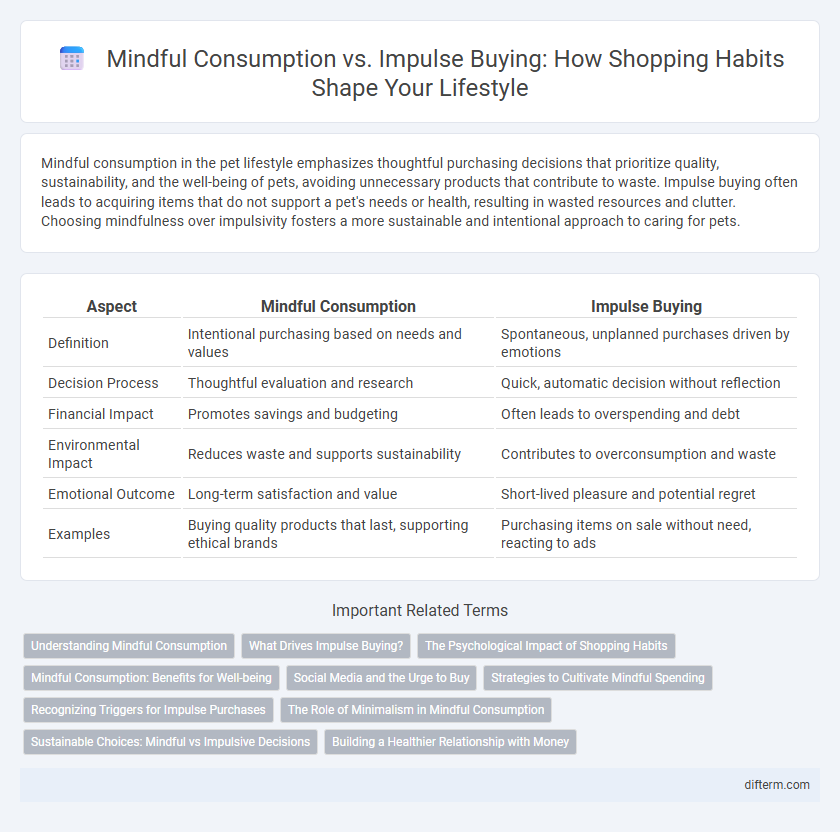Mindful consumption in the pet lifestyle emphasizes thoughtful purchasing decisions that prioritize quality, sustainability, and the well-being of pets, avoiding unnecessary products that contribute to waste. Impulse buying often leads to acquiring items that do not support a pet's needs or health, resulting in wasted resources and clutter. Choosing mindfulness over impulsivity fosters a more sustainable and intentional approach to caring for pets.
Table of Comparison
| Aspect | Mindful Consumption | Impulse Buying |
|---|---|---|
| Definition | Intentional purchasing based on needs and values | Spontaneous, unplanned purchases driven by emotions |
| Decision Process | Thoughtful evaluation and research | Quick, automatic decision without reflection |
| Financial Impact | Promotes savings and budgeting | Often leads to overspending and debt |
| Environmental Impact | Reduces waste and supports sustainability | Contributes to overconsumption and waste |
| Emotional Outcome | Long-term satisfaction and value | Short-lived pleasure and potential regret |
| Examples | Buying quality products that last, supporting ethical brands | Purchasing items on sale without need, reacting to ads |
Understanding Mindful Consumption
Mindful consumption involves making deliberate purchasing decisions based on needs, values, and long-term benefits, contrasting sharply with impulse buying driven by spontaneous emotions and external triggers. This approach encourages awareness of environmental impact, budget constraints, and product quality, fostering sustainable habits and financial responsibility. Emphasizing mindful consumption enhances overall well-being by promoting intentionality and reducing waste.
What Drives Impulse Buying?
Impulse buying is driven primarily by emotional triggers such as stress, excitement, or social influence, prompting spontaneous purchasing decisions without thorough consideration. Marketing techniques like limited-time offers, eye-catching displays, and targeted ads exploit psychological urges, increasing the likelihood of unplanned purchases. Understanding these drivers helps consumers shift towards mindful consumption by fostering awareness and deliberate decision-making.
The Psychological Impact of Shopping Habits
Mindful consumption fosters intentional decision-making, reducing stress and promoting emotional well-being by aligning purchases with personal values and needs. Impulse buying often triggers dopamine release, leading to temporary satisfaction followed by guilt or regret that can negatively impact mental health. Developing awareness of shopping habits helps break cycles of compulsive spending, supporting long-term psychological balance and financial stability.
Mindful Consumption: Benefits for Well-being
Mindful consumption enhances well-being by promoting intentional choices that reduce stress and increase satisfaction with purchases. This practice supports mental clarity and financial health by encouraging thoughtful evaluation of needs versus wants. Embracing mindful consumption helps build sustainable habits that foster emotional balance and long-term happiness.
Social Media and the Urge to Buy
Social media platforms increasingly influence consumer behavior by promoting impulsive buying through targeted ads and curated content that trigger emotional responses. Mindful consumption encourages intentional purchasing decisions by fostering awareness of these triggers and advocating for evaluating needs over momentary desires. Understanding the psychological impact of social media fosters better control over spending habits and supports sustainable lifestyle choices.
Strategies to Cultivate Mindful Spending
Cultivating mindful spending involves setting clear budgets that align with personal values and long-term goals to reduce impulse buying. Practicing delayed gratification through techniques like the "24-hour rule" encourages reflection before making purchases. Tracking expenses with apps or journals enhances awareness of spending patterns, promoting intentional decisions over spontaneous shopping.
Recognizing Triggers for Impulse Purchases
Recognizing triggers for impulse purchases involves identifying emotional and environmental cues such as stress, boredom, or targeted advertisements that prompt spontaneous buying decisions. Mindful consumption requires awareness of these triggers to make intentional choices aligned with long-term values and financial goals. Techniques like keeping a shopping list and setting budgets help reduce susceptibility to impulse buying by fostering deliberate spending habits.
The Role of Minimalism in Mindful Consumption
Minimalism encourages mindful consumption by promoting intentional purchasing decisions and reducing unnecessary clutter. Emphasizing quality over quantity, minimalism helps consumers prioritize essential items that add value to their lives, contrasting sharply with impulse buying driven by emotional triggers. This lifestyle shift fosters financial savings, environmental sustainability, and a greater sense of personal well-being.
Sustainable Choices: Mindful vs Impulsive Decisions
Mindful consumption prioritizes sustainable choices by carefully evaluating the environmental and social impact of each purchase, reducing waste and promoting long-term value. Impulse buying often leads to unnecessary acquisitions that contribute to overconsumption and increased carbon footprints. Choosing mindful decisions supports ethical brands, resource conservation, and a balanced lifestyle focused on intentional, eco-friendly spending.
Building a Healthier Relationship with Money
Mindful consumption emphasizes intentional spending based on values and needs, fostering financial well-being and reducing unnecessary purchases that lead to debt. Impulse buying often results in regret and disrupts budgeting, highlighting the importance of cultivating awareness around spending habits. Developing a healthier relationship with money involves tracking expenses, setting realistic financial goals, and practicing delayed gratification to strengthen control over personal finances.
Mindful Consumption vs Impulse Buying Infographic

 difterm.com
difterm.com